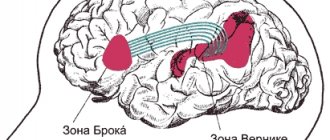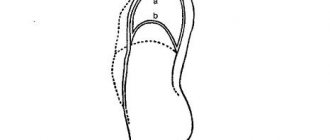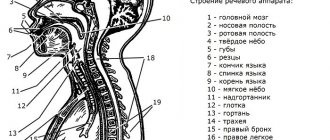Structure of the hearing organ
Sounds surround a person from birth. There are 3 sections of the hearing organ:
- outer ear;
- middle ear;
- inner ear.
The outer ear is the visible part of the organ. It is represented by the auricle and the external auditory canal. The concha is a funnel-shaped cartilage covered with skin. On its surface there are various formations: pits, curls, hills. They help improve sound quality, make it louder and direct it into the ear canal.
The fibers of the ear muscles are attached to the concha. In the process of evolution, man has lost the ability to “move his ears” in order to more accurately localize sounds; these muscles work in rare “lucky” people. The skin of the shell has sebaceous and sweat glands.
The external auditory canal is a winding canal, the length of which is slightly more than 2 cm, and the diameter is up to 0.7 cm. In it, the sound signal continues to be amplified and transmitted to the middle ear. The passage is lined with skin containing sebaceous and sulfur glands. Earwax is a yellowish substance that provides hydration to the canal and protection against infectious agents. When accumulated and compacted, it forms plugs that disrupt the movement of the eardrum. This can lead to conductive hearing loss.
Describing the structure of the hearing organ, anatomists indicate that the outer part of the canal has cartilaginous walls, and the part in contact with the middle ear has bone walls. The structures of the middle and inner ear are located in the body of the temporal bone.
The eardrum is a thin membrane covered on the outside with skin and on the inside with mucous membrane. In young children, it has an opening that exposes the middle ear to the outside environment and is more vulnerable to infection. It closes by 3 years.
The middle ear is a cavity whose volume is slightly more than 1 cubic centimeter. It contains three small auditory ossicles, which are connected to each other in a chain:
- hammer;
- anvil;
- stapes.
They are named so because of their resemblance to everyday objects. The stapes connects to the window of the vestibule. The middle ear is also connected to the nasopharynx via the Eustachian tube.
The inner ear is the most bizarre formation of the human hearing organ. It consists of:
- vestibule (vestibulum);
- snails;
- semicircular canals.
The organ of hearing includes only the cochlea. It contains lymphatic fluid and stretches fibers (the main membrane). Each of the fibers is like a small string and “responds” (resonates) to a sound of a certain frequency. There are about 25 thousand of these fibers. On the wall of the cochlear canal there is a receptor field, which consists of nerve (hair) cells - the organ of Corti. The death of hair cells can lead to sensorineural hearing loss.
Speech organs and their mechanisms
Generated by the needs of social life, our speech is carried out by an extremely complex anatomical and physiological apparatus, consisting of central and peripheral speech organs . The central organ consists of the brain, mainly the cortex of its cerebral hemispheres. The peripheral organs include the organs of hearing, breathing, voice, and articulation. Inextricably linked and interacting under the leading regulatory influence of the central nervous system, all speech organs represent a complex functional system in which each of them plays its own specific role. Violation of one of them affects the activities of the others.
The central organ of speech and its mechanisms
The cerebral cortex, in turn, is a complex functional system of interacting various analyzers (auditory, motor, visual, etc.). The cortex carries out the physiological basis of speech - the second signaling system, inextricably linked and interacting with the first signaling system.
I.P. Pavlov, by the second signaling system, meant not only speech as a means of communication, but associated it with the ability to generalize, abstract, with “specially human higher thinking.” Consequently, the cortex is the central organ of speech that regulates others. This is proven by the possibility in some cases, with a healthy brain, to learn to speak without hearing and voice, to write without hands: the brain can adapt other organs for speech. The brain acts holistically in any act, as a single functional system. Therefore, speech is the result of the holistic work of the entire brain.
In the cortex, under the influence of speech stimuli from the environment and depending on the state of the nerve cells at any given moment, temporary nerve connections can be formed in any part of it. As a result of processing the latter by higher analysis and synthesis associated with certain structures (constructions) of the brain, conditioned second-signal (speech) reflexes arise. The localization of speech functions of the cortex is not only very complex, but also variable, which is why it was named I.P. Pavlov dynamic localization. Speech reflexes are acquired by a child individually through life experience, arise as a result of the simultaneous complex activity of auditory, visual, motor, kinesthetic, skin and vibration analyzers and are expressed in the form of speech sounds, syllables, words and phrases. As a result of long-term repeated influences in the same sequence of a certain group of speech stimuli, a relatively stable complex of conditioned reflexes (sounds, words, phrases) is formed in the brain, which is resumed when the complex stimulus is repeated, in whole or in part. Such a complex is carried out by the corresponding temporary connection of nerve cells, forming continuously changing “constellations”. This coherent, balanced system of internal processes by I.P. Pavlov calls it a dynamic stereotype. Human stereotypes are qualitatively more complex than animal stereotypes. They are the result of both the specific patterns of the second signaling system and its effects on the first signaling system.
Peripheral speech organs
The executive devices of sound speech, the activity of which is regulated by the brain, are: 1) the organs of hearing that perceive and control speech, and partly of vision; 2) sound-producing organs: respiratory muscles of the abdomen and chest, diaphragm, lungs, larynx, soft palate with uvula, oral and nasal cavities, tongue, teeth and lips (Fig. 1).
In pronunciation, an important role is played by the sense of movement of the organs that produce sound (especially the tongue), and to some extent, touch. The more often and better these organs work, the more the brain itself develops under the influence of the stimuli coming from them and controls them more accurately.
Particularly noteworthy is the extraordinary role of hearing in auditory speech: a child deprived of hearing from an early age, without special training, cannot imitate the speech of adults and therefore remains mute, but for communication uses a primitive means - gesture and facial expressions. What kind of peripheral speech organs does a person have?
1. Breathing apparatus (Fig. 1 and 2). a) Lungs, which are like bellows, filled with air and consisting of individual elastic communicating vesicles (alveoli). The lungs supply the larynx, mouth and nose with a stream of air necessary for sound pronunciation. b) The chest, to the walls of which the lungs are tightly adjacent. By contracting the strong external intercostal muscles, it expands and stretches the lungs (during inhalation); due to the heaviness of its walls, the elasticity of the lungs, and partly the contraction of the weaker internal intercostal muscles, it collapses and compresses the lungs (during exhalation). c) The diaphragm is a powerful flat muscle that separates the chest cavity from the abdominal cavity. When contracting, it becomes denser and, falling down, frees up space for the lungs and thereby increases their capacity (inhalation); sticking out with two domes upward and pressing on the bases of the lungs, displaces air from them (exhalation). d) The abdominal muscles, when contracting, press on the intestines and through it on the diaphragm - promote exhalation; protruding forward during intense inhalation, they facilitate the lowering of the diaphragm during inhalation.
Breathing carried out by movements of the chest is called thoracic; produced with the help of the diaphragm and abdominal muscles - diaphragmatic, or abdominal. Children use a combined thoraco-abdominal type of breathing, which is most beneficial for speech and healthy (as it is the easiest, most economical, smoothest and richest in the amount of exhaled air). Some children experience upper thoracic or clavicular breathing (with it, the shoulders are raised, and the air enters mainly the tops of the lungs). This type of breathing is harmful to health, and children should be weaned from it.
Inhalation requires much more effort than exhalation, during which the chest collapses under the influence of its own gravity, and the lungs themselves tend to contract. This must be remembered during all kinds of games and exercises for developing breathing.
2. Larynx (Fig. 3, 4, 5). This vocal apparatus is a small box consisting of a whole system of large and small cartilages, movably articulated with one another and driven by a system of muscles. Its main part is the vocal cords - two elastic muscle folds that protrude in the form of rollers from the inner walls of the thyroid cartilages. In front, the cartilages converge at an acute angle (Adam's apple). At the back, the ligaments are attached to two movable cartilages, which, converging and diverging, sometimes push them apart, sometimes close them (the glottis opens and closes). In addition, the vocal cords, contracting, can themselves move closer to one another. Other muscles of the larynx are also involved in the movement of the ligaments.
During normal breathing, the glottis is open and air passes through it freely. This is how the voice is formed. A stream of air coming from the lungs encounters the closed vocal cords and with force, in small jolts, breaks through between them.
Rice. 3. Internal view of the anterior part of the larynx. 1 - thyroid cartilage; 2 - cricoid cartilage; 3 - epiglottis; 4 - section of the hyoid bone; 5 - trachea; 6 - blinking ventricle; 7 - false vocal cord; 8 - true vocal cord.
Under air pressure, the ligaments rhythmically oscillate (vibrate) - a musical sound is obtained, which is called the primary tone. These vibrations in turn cause vibrations in all cavities communicating with the laryngeal cavity (subglottic and supraglottic space - pharynx, mouth, nose, etc.). And in them the main tone for each speech sound and additional tones (overtones) are formed, which, merging with the main tone, form the sound of the human voice that we hear. The action of the larynx is similar to the action of a reed organ pipe (Fig. 5): the reeds, under the influence of a stream of air and springs, quickly and rhythmically close and open, resulting in a sound.
The stronger the air pressure on the vocal cords (the resulting large range of vibrations), the larger the resonating cavities, the stronger the voice. The pitch of the voice depends on the number of vibrations of the vocal cords per second. The larger the larynx, the longer the vocal cords and, therefore, the less vibration, and therefore the lower the pitch of the voice. Children have shorter vocal cords than adults, so children's voices are higher than adults' voices.
Depending on the ratio of the time of the exhalation stream of air and the rapprochement of the vocal cords, three types of voice formation, or attack (attack, vocal beginning) are distinguished: hard, soft and aspirated.
A hard attack is more often observed when negative emotions (anger, malice, irritation) are expressed in the voice. A hard attack occurs because the air approaches the vocal cords at the moment when they have time to tensely come together. When air breaks through them, a sharp, strained beginning of a voice is heard, for example: “Oh, how painful!” or irritably: “Olya, sit on the chair.” Screaming and speaking tensely, irritably, and swearing is harmful to the voice. A mild attack is formed by the gradual rapprochement of the ligaments already at the moment of air passage - a pleasant, soft voice is heard. For example: “Oh, what a beautiful flower!”, “Olya, kiss me.”
Rice. 4. Top view of the larynx: glottis a - open glottis during breathing; b - when a voice sounds; c - when whispering; g - with falsetto.
An aspirated attack is caused by the passage of air before the vocal cords begin to approach each other, so a slight exhalation is heard before the voice, like the German sound p.
3. Extension pipe (Fig. 1, 6). It consists of a number of different cavities (pharynx, nasopharynx, nose, mouth) and organs of articulation (soft palate, hard palate, tongue, teeth, jaws, lips) associated with the larynx and located above it. The extension pipe gives the sound a certain color (timbre) and shape.
Rice. 6. Oral cavity: 1 - soft palate; 2 - tongue; 3 - palatine tonsils; 4 - tongue; 5 - palatopharyngeal arches; 6 - palatine-lingual arches; 7 - posterior wall of the pharynx; 8 - hard palate.
a) The pharynx is a wide canal from the base of the skull to the esophagus, its part in front of the palate is called the nasopharynx; The space between the soft palate and the root of the tongue is called the pharynx. These cavities, being the expanded end of the respiratory tube, facilitate inhalation: air passes through the pharynx into the mouth, through two openings (choanae) into the nose and into the tympanic cavity of the ear (from the pharynx through the Eustachian tube). b) The soft palate is a muscular continuation of the hard palate, ending in a uvula. If necessary, straining, it rises upward and, pressing together with the tongue against the back wall of the throat, closes the air passage into the nose. c) The hard palate is a bony dome-shaped arch that enhances the sound of the voice. d) Teeth and jaws strengthen the voice and clarify (especially the incisors) the pronunciation of sounds. With normal jaws and teeth, the upper teeth somewhat overlap (capture) the lower teeth, tightly closing with them. It is impossible to push the lower jaw forward when making the sounds ы, Ж, ч, Ш, щ, which is observed in practice. e) Lips, giving various shapes to the mouth opening, thereby modify sounds. f) The tongue is the main organ of sound production. It is a complex complex of many muscles located and acting in different directions and directly connected with other organs of pronunciation. Thanks to its great flexibility and mobility, changing its position and shape, it changes the oral cavity in various ways, forming a narrowing in it, then closing with different parts of it, and to a certain extent affects the function of the vocal and respiratory organs. As a result of such plasticity of the language, a rich complex of various speech sounds is created. g) The nose is a rather large cavity, divided by a longitudinal plate (vomer) into two chambers, which amplifies the voice and gives it a special timbre when the vocal respiratory stream passes through the nose. 4. Ear (Fig. 7)
Rice. 7. Structure of the ear: 1 - external auditory canal; 2 - eardrum; 3 - middle ear cavity; 4 - hammer; 5 - anvil; 6 - stirrup, resting on the oval membranous window; 7 - semicircular canals; 8 - vestibule; 9 and 10 - snail; 11 — round window; 12 - Eustachian tube; 13 — bone in section.
The organ of hearing, the ear, consists of three sections: external, middle and internal. The sound wave reaches the eardrum through the ear canal and causes it to vibrate, which is transmitted to the movably articulated auditory ossicles (hammer, incus and stapes) located in the middle ear. The middle ear is filled with air that enters it from the mouth through the Eustachian tube. Vibrations of the auditory bone chain, which at the other end is attached to the elastic membrane separating the middle ear from the inner ear, together with air vibrations are transmitted to the inner ear, filled with a special liquid. In the inner ear, in addition to the apparatus for maintaining balance (the semicircular canals), there is the auditory cochlear apparatus, which houses the very thin and complex organ of Corti. It contains special auditory cells with hairs connected to the auditory nerve. The vibrations propagated through the liquid irritate the hairs of the auditory cells. These irritations are transmitted along the auditory nerve to the brain, where we are aware of them as speech sounds.
Khvattsev I. Yu.
Need a consultation with a neurologist? Sign up by phone or through the feedback form in the “Contacts” section.
What is the organ of hearing and balance?
The human ear is responsible not only for the perception and further transmission of sound information. The inner ear is the organ of hearing and balance. This is a complex formation in which a wave of mechanical vibrations, like sea surf, spreads through the lymphatic fluid and sways the processes of nerve cells, forming an electrical impulse. This signal carries information about the volume, duration, and pitch of sound to the brain.
Another part of the inner ear is the organ of balance (vestibular apparatus). It consists of: the vestibule, the three semicircular canals located in it, the utricle and the sac. The vestibule is a round-shaped cavity with a diameter of about 5 mm. It is located between the canals and the cochlea. The canals are mutually perpendicular and at the junction with the vestibule they have expansions - ampoules. The channels are filled with endolymphatic fluid.
The utricle and saccule are fields of nerve cells that perceive various irritations. A change in body position is registered by the receptors of the uterus and causes a reflex reaction of the muscles, helping a person maintain balance. The vibration is picked up by the ends of the sac.
The vestibulocochlear nerve runs from the organ to the brain.
1.1. Speech sounds
Speech sounds are the sounds that make up words. Sound is the smallest unit of language.
1. The sounds of speech, like all other sounds of nature (the sounds of human steps, car horns, birdsong, etc.), are generated by air vibrations, that is, the sounds of speech [a], [b], [c], [o] are to acoustic phenomena, they are perceived by the hearing organs as different sounds.
2. Air vibrations occur when an air stream passes through the speech apparatus.
- The speech apparatus consists of the lungs, larynx with vocal cords, pharynx, oral cavity (with tongue, lips, hard and soft palate) and nasal cavity.
- The function of the lungs is to provide a stream of air.
- All other organs of the speech apparatus are directly involved in the formation of sounds. When “speaking,” some of them move (vocal cords, soft palate, tongue, lips); these speech organs are called active ; others remain motionless (hard palate, teeth), they are called passive .
- As a result of the work of the vocal cords (or lack thereof) and the friction of air against obstacles, different sounds are created - different sounds.
- Obstacles are created by the unequal position of the active organs of speech at the moment of sound formation. Consequently, sound is also a physiological phenomenon: its occurrence requires a certain work of the speech organs.
3. The sounds [a], [b], [c], [o], etc. are elements of language, the function of which, as is known, is to convey meaning. Therefore, speech sounds are associated with the meanings of words and their parts (morphemes - roots, prefixes, etc.). By changing sounds you can turn one word into another.
Wed: house, smoke, I’ll give (you a book), (many) thoughts; home, vol.
4. Speech sounds are not used in isolation, but in certain sound complexes - words. This leads to the fact that the same sound in the Russian language can sound differently in different words.
Compare: in the word rezok the sound [z] sounds in place of the letter z; in the word sharp, the sound [s] sounds in place of the letter z.
5. Words can consist of one or more sounds. Conjunctions, prepositions, and pronouns are usually the shortest. For example, the prepositions k, v, s consist of one sound; conjunctions a, and. Words of significant parts of speech usually consist of three or more sounds.
House, table, bicycle, approached, beautiful.
6. The branch of science in which speech sounds are studied is called phonetics (from the Greek “phone” - sound).
7. Closely related to phonetics is orthoepy , a science that studies standard literary pronunciation (from the Greek “ortho” - correct; “epic” - word, speech). The pronunciation of speech sounds, placement of stress, etc. are subject to orthoepic norms.
For example, according to the orthoepic norms of the literary language, the first sound in the pronoun is pronounced [w]; the consonant [n] in the stressed syllable of the word phonetics is pronounced firmly; The stress in a noun alphabet is placed on the last syllable.
The correct pronunciation of words can be checked using spelling dictionaries.
►
Functions of the hearing organ
When talking about the functions of the hearing organ, physiologists describe them in accordance with their anatomical structures. So, each department has its own specific tasks:
- catches sounds and directs them further (outer ear);
- transmits sound waves (outer and middle ear);
- protects against infections, loud sounds, damage to internal parts (outer ear, eardrum);
- transforms sound energy into electrical energy (inner ear).
The functions of hearing are evolutionarily closely related to danger notification and communication in the community. In order to maintain your ability to hear for a long time, you must follow simple rules for preventing hearing loss.
Features of the hearing organ
Human hearing organs are paired. What does this mean? A person can listen with both the right and left ear at the same time. Binaural hearing gives more information about the sound and amplifies it under certain conditions.
If the source of mechanical vibrations is at the same distance from the right and left ears, the signal volume increases by 50%. This means that in case of unilateral impairment, compensation with the help of a hearing aid of even low power significantly improves the quality of life.
Perceiving with two ears is better for determining the localization of sound. Binaural hearing gives:
- surround sound sensation;
- idea of the location of the source.
This helps you avoid danger (such as an approaching car) and isolate useful sounds from all the background noise when talking to one person in a noisy room.
Read more about hearing characteristics in this article.
If you experience any hearing problems, you must urgently undergo a hearing test using professional equipment. If you seek help in time, you have a chance to fully restore your hearing.










